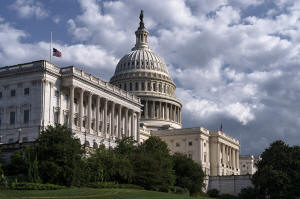Unemployment, inflation and GDP growth will be worse this year than
projected, budget office says
[September 13, 2025] By
FATIMA HUSSEIN
WASHINGTON (AP) — President Donald Trump’s tariff policy, immigration
crackdowns and sweeping tax and spending law are expected to increase
jobless rates and inflation and lower overall growth this year before
they improve next year, according to a new report from the nonpartisan
Congressional Budget Office.
The CBO on Friday released new economic projections for the next three
years, updating the outlook it originally released in January, before
Trump's inauguration.
The latest figures, which compare fourth quarter changes, show the
unemployment rate, inflation and overall growth are expected to be worse
this year than initially projected, while the economic picture is
expected to steady in subsequent years.
The CBO outlooks attempt to set expectations for the economy in order to
help choices made by congressional and executive branch policymakers. It
does not forecast economic downturns or recessions, with its estimates
generally reverting back to an expected average over time.
But Friday’s outlook showed the degree to which Trump’s choices are
altering the path of the U.S. economy, suggesting that growth has been
hampered in the near term by choices that have yet to show the promised
upside of more jobs and lower budget deficits.

Kush Desai, a White House spokesperson, told The Associated Press,
“Americans heard similar doom-and-gloom forecasts during President
Trump’s first term, when the President’s economic agenda unleashed
historic job, wage, and economic growth and the first decline in wealth
inequality in decades.”
“These same policies of tax cuts, tariffs, deregulation, and energy
abundance are set to deliver — and prove the forecasters wrong — again
in President Trump’s second term,” he said.
Overall, the CBO expects real GDP growth to decrease from 2.5% in 2024
to 1.4% this year, a downgrade from the initial projection of 1.9%. The
CBO attributes the projected decline to a slowdown in consumer spending
stemming from new tariffs and a decrease in immigration, which would
also impact consumer spending.
[to top of second column] |

The west front of the Capitol is seen in Washington, Thursday, Sept.
11, 2025, where the flags have been lowered to half-staff after the
assassination of conservative activist Charlie Kirk. (AP Photo/J.
Scott Applewhite)
 The tariffs “raise prices for
consumer goods and services, thereby eroding the purchasing power of
households; they also increase costs for businesses that use
imported and import-competing inputs in production,” the report
says.
However, GDP is set to grow to 2.2% in 2026, which is higher than
the CBO's January prediction of 1.8%. GDP would then level off to
1.8% in 2027 and 2028, the CBO says in its latest report.
Additionally, unemployment is expected to hit 4.5% in 2025, higher
than the 4.3% initially expected, according to the CBO. The jobless
rate is expected to reach 4.2% in 2026 — slightly lower than the
4.4% originally anticipated — and even out at 4.4% in 2027 and 2028.
And inflation is now expected to hit 3.1% for the rest of 2025,
according to the CBO, up from its 2.2% projection in January.
Inflation would then lower to 2.4% in 2026, higher than the initial
expectation of 2.1%, before leveling off at 2% the next two years.
The CBO on Wednesday issued a report that shows Trump’s plans for
mass deportations and other hard-line immigration measures will
result in roughly 320,000 people removed from the United States over
the next ten years.
Coupled with a lower fertility rate in the U.S., the reduction in
immigration means that the CBO’s projection of the U.S. population
will be 4.5 million people lower by 2035 than the nonpartisan office
had projected in January.
___
Associated Press writer Josh Boak in New York contributed to this
report.
All contents © copyright 2025 Associated Press. All rights reserved |